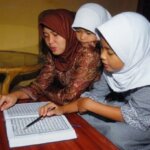The Quran is the word of Allah, meant to be read, understood, and internalized, serving as a guide for a happy life in this world and the hereafter. The first command given to the Prophet Muhammad when he became a messenger was “iqra’,” which means “read.”
Therefore, reading the Quran is the first step toward understanding its content, allowing it to be practiced in one’s life. With the advancement of technology, parents often neglect to teach their children how to recite the Quran. In today’s world, many parents prioritize general education over religious studies.
Consequently, many individuals reach adulthood without being able to recite the Quran, even though it is obligatory for every Muslim to do so. If you are one of these individuals, there is no need to worry. It is never too late to learn how to recite the Quran. In a hadith, the Prophet Muhammad (peace be upon him) said, “The best among you are those who learn the Quran and teach it.”
As times have changed, there are now various Quranic recitation methods available, designed to make learning easier to understand. You can choose the approach to learning to recite the Quran that suits you best. There are numerous methods to choose from. Ultimately, each method aims to help you read the Quran correctly and effectively. Here are the most popular Quranic recitation methods in Indonesia:
1. Learning to Recite Using Iqro’
This method emphasizes immediate practice in Quranic recitation. The materials consist of six volumes, with complexity increasing with each additional volume as more Tajweed lessons are included. The Iqro’ method was developed by Ustaz As’ad Human in Yogyakarta. Each volume includes instructional guidance, facilitating both the teaching and learning processes.
In practice, Iqro’ requires learners to read actively without relying on the Arabic alphabet’s Hijaiyah letters, which learners must understand individually. However, a drawback of this method is the lack of comprehensive learning materials, limiting a teacher’s ability to provide in-depth lessons.
2. Reciting Quran with the Qira’ati Method
The Qira’ati method was developed by KH. Dahlan Salim Zarkasyi in Semarang. This approach indirectly encourages students to practice proper recitation in line with the Tajweed rules.
The Qira’ati book consists of six volumes, with an additional 27th Juz after the 5th volume, followed by two supplementary sections: Ghorib and Tajweed. Advancement from one volume to the next depends on the learner’s fluency and mastery of the content in the tested volume.
3. Reciting Quran with the Tilawati Method
The Tilawati method strikes a balance between individual and classical approaches to recitation as part of students’ routines. It consists of six volumes with added sections on Ghorib and Tajweed.
The approach to this method is practical, with classical teaching through demonstrations and individual reading, using books. To support the learning process, various teaching aids and materials are available.
4. Learning with the Al-Baghdadi Method
The Al-Baghdadi method was the first Quranic recitation method to emerge in Indonesia. It follows a sequence of introducing Hijaiyah letters starting with Alif, Ba’, Ta’, and so on.
While it is practical to introduce learners to Hijaiyah letters first, the method entails spelling out each letter, making it less efficient. However, it enables faster learners to complete their Quranic reading faster, without waiting for others.
5. Utilizing the An-Nahdhiyah Method
The An-Nahdhiyah method originates from Tulungagung, East Java, and is devised by the LP Ma’arif branch in Tulungagung. It features both introductory and advanced programs that ensure students understand and apply Quranic recitation. The method introduces three Quranic recitation systems: Tartil, Tahqiq, and Taghanni.
It’s worth noting that books or materials for the An-Nahdhiyah method are not available for sale; teachers must have completed training to access the curriculum. The emphasis of this method is on regularity and adherence to specific rhythms in recitation.
In conclusion, these are the most popular Quranic recitation methods frequently found in Indonesia. The primary goal of all these methods is to enable students to recite the Quran accurately and practice its teachings in their daily lives. You are free to choose the method that best suits your individual abilities and needs.







